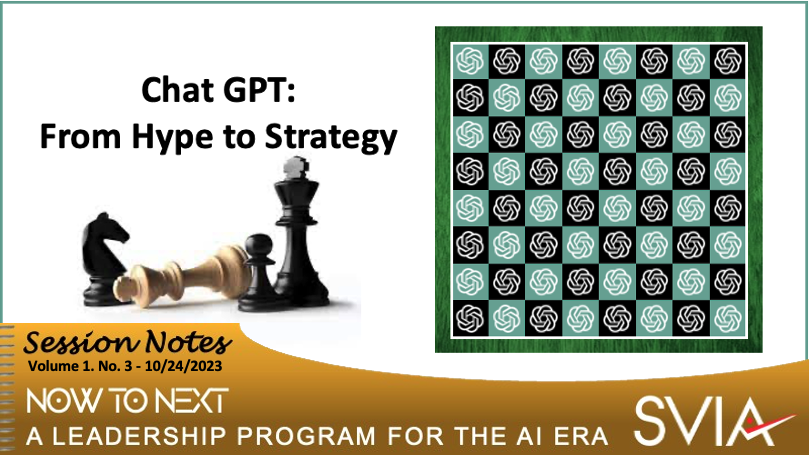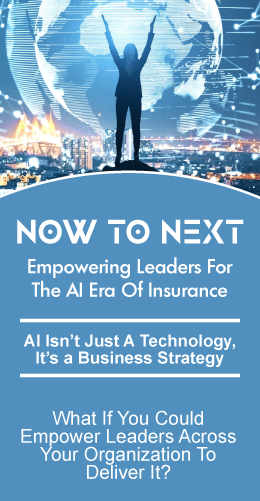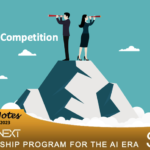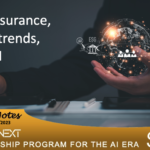
The buzz around AI, especially ChatGPT, is almost deafening in today’s rapidly evolving digital landscape. But beyond the hype lies immense strategic potential. This article helps executives understand what ChatGPT is and how it works. This insight will enable them to assess where and how it can help them build a strategic advantage for their business and provide the steps needed to implement those strategies.
This article explains how Large Language Models (LLMs) like ChatGPT work and how you can use them strategically. I’ve used underwriting as an example. But to be clear, digitally savvy competitors will use these advanced AIs to create strategic advantages across the insurance value chain. These capabilities will dramatically change customer engagement and experience, sales and distribution, policy development and management, and claims, among other functions.
ChatGPT and its counterparts use sophisticated machine learning techniques, including neural networks, to decipher and generate pertinent responses to given prompts – the questions we ask or the tasks we assign. Think of a neural network as a digital brain; human experts and automated processes continually train it to understand and make connections in the data it processes.
When trying to understand how ChatGPT works, think of its components as parallel to the key stages and tools used in underwriting:
Tokenization (similar to Risk Assessment): Much like an underwriter categorizes different aspects of a house—its age, build material, location—ChatGPT divides a prompt into tokens, which can be phrases, words, or even characters. It dissects information for further analysis in this way.
Positional Encoding (similar to Contextualization): An underwriter doesn’t just assess a house’s age without considering its location. In the same way, ChatGPT understands the position of each token within a prompt to ensure its relevance and context.
Self-Attention Mechanism (similar to Reference Checks): Just as underwriters weigh various factors differently (e.g., the weightage given to a house’s age versus its location), this mechanism allows ChatGPT to determine the importance and relationship of different tokens to the overall meaning of the query.
Feed-forward Neural Networks & Stacking Layers (similar to Deep Analysis): These components allow ChatGPT to deeply understand the intricacies of a prompt, much like an underwriter analyzing multiple records and data sources to determine policy specifics.
Decoding (similar to Policy Drafting): After analyzing, ChatGPT begins crafting a response, similar to how an underwriter drafts a policy, starting with core terms and incrementally adding details.
As it composes a response, the AI pulls relevant information from its vast database, aligning it with its understanding of the prompt. It prioritizes the most critical aspects of the prompt, progressively adds details, and ensures the answer remains coherent and matches the intent of the prompt.
Before presenting its response, the AI fine-tunes the language to ensure it’s grammatically correct and contextually appropriate, much like an underwriter would ensure all policy clauses are clear and precise.
Making ChatGPT A Member Of The Underwriting Team
Incorporating ChatGPT into the underwriting process is like adding a knowledgeable colleague to your team, one who has sifted through vast amounts of information on underwriting, industry trends, and historical data. However, instead of giving subjective opinions, this ‘colleague’ provides data-driven insights based on patterns recognized during its expansive training.
Policy Recommendation:
Just as underwriters use a combination of standardized guidelines and personal experience, ChatGPT would take a similar approach. Given a specific scenario or set of homeowner details, you can query ChatGPT for policy recommendations. Based on patterns from its training data, it might suggest typical coverage areas, exceptions or even flag potential high-risk factors.
Pricing:
For pricing, you could ask ChatGPT to analyze large datasets of historical policy pricing and related claim outcomes. It then combines that with forward-looking information like climate, crime, and property value trends. This information can identify patterns and correlations, providing insights like “Homes in X area with Y characteristics typically have a 10% higher premium due to Z reasons.”
Caveats:
Training Data Quality: Just as an underwriter’s judgment is only as good as their training and experience, ChatGPT’s recommendations heavily rely on the quality and breadth of its training data. Biases or gaps in this data might produce skewed insights.
Think of ChatGPT as a Partner, Not a Replacement: While ChatGPT can process information rapidly and identify patterns, it doesn’t inherently possess human intuition or the ability to understand the nuances of human behavior and external socio-economic factors. Therefore, it works best as a complementary tool, enhancing an underwriter’s intuition and capabilities rather than replacing them.
Interactivity & Iteration: ChatGPT’s strength lies in its interactivity. If it suggests a certain pricing approach, underwriters can probe the rationale, ask for alternatives, or request further analysis on specific factors. Over time, this iterative process can refine the model’s relevance to specific underwriting tasks.
While ChatGPT isn’t natively built to make policy decisions, with the right training and iterative feedback, it can aid the underwriting process, supporting decision-making with data-driven insights and rapid information processing.
Integrating AI Into Corporate Strategy
How do you transform advanced AIs like ChatGPT from buzz into a strategic advantage? The underwriting example showcases ChatGPT’s capabilities, but its potential extends way beyond that.
Companies planning to leverage ChatGPT to gain a strategic advantage must see it not just as a technology or tool. They must recognize it as something that will radically reshape our society and economy and use it as a catalyst to prepare their organization for an AI-centric future. It’s a journey that demands discussion, investment, and cultural adaptation. Each company’s path will differ, but there are clear starting points.
Here’s what you need to consider.
Vision for an AI Future: As a board of directors and C-Suite executives, you must create a deeply informed vision for how to use AI to create and deliver value in the context of an AI economy and an AI-powered insurance industry. Think of it this way. Would you make a major acquisition without thoroughly understanding the company you are acquiring and what will be required to ensure the acquisition delivers the strategic goal you had in mind? No, you wouldn’t. You need to think of AI at this level of impact and even greater.
Start by Identifying Easy-to-Address Opportunities: First, pinpoint areas where AI can provide the most impact with relatively little investment and risk. This could range from customer service enhancements (e.g., chatbots) to intricate tasks like data analysis or predictive modeling. Understand the AI’s capabilities and limitations to find the best fit. Think of initial initiatives as training wheels that build knowledge and confidence.
Pilot Projects: Instead of a full-blown implementation, start with small pilot projects. This approach gives a clearer understanding of the benefits, challenges, and adjustments needed for broader adoption.
Training & Feedback Loop: One of AI’s strengths is its learning ability. Implement a feedback loop where human experts can correct and guide the AI. This iterative process refines its output over time, aligning it more closely with business objectives.
Ethics & Transparency: Ensure you have ethical guidelines, especially regarding user data. Maintaining transparency about how AI decisions are made is crucial, ensuring they’re free from bias and align with the company’s values.
Skill Development: AI will reshape job roles. Invest in training programs to upskill employees to work effectively alongside these tools.
Stay Updated: The field of AI evolves rapidly. Keep a pulse on the latest advancements, ensuring your business stays competitive.
Focus on Human-AI Interaction: The best AI-powered customer interactions feel intuitive and human-centered. Avoid the pitfall of making customer interactions too mechanical.
Scalability: As dependence on AI grows, so will your infrastructure needs. Consider scalable solutions like cloud platforms or dedicated servers to support increased processing.
Work With Experts: Forge partnerships with AI experts, research institutions, or tech companies. These collaborations can bring deeper insights and help in overcoming technical hurdles.
Risk Management: As with any major technological adoption, there are inherent risks. Address these risks proactively with strategies that include regular data backups, robust cybersecurity measures, and contingency plans.
Vision & Leadership: Integrating AI isn’t just about technology adoption. It demands a vision. Leaders must spearhead this transition, ensuring that the organization is poised to take advantage of AI’s rapidly maturing capabilities. Continual training and updating of leadership skills are crucial as AI reshapes the corporate landscape.
Incorporating ChatGPT and other advanced AIs into your corporate strategy isn’t just a good idea; it’s essential. The digital era demands that businesses continually innovate. Those who harness the power of AI effectively will lead the way. Those that don’t may struggle to remain relevant.
This is a pivotal moment in the insurance industry. We urge you to ignite this critical conversation within your organization.







